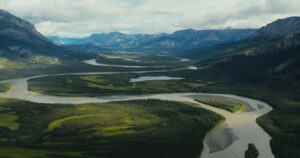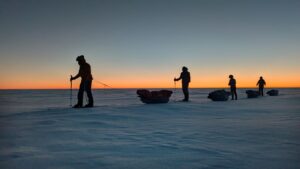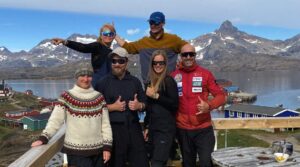Most casual readers of adventure would be led to believe there are few worthwhile expeditions beyond the Greater Ranges or Poles. But if you cast your eyes past these honeypots, there is a lifetime of possibilities. With its vast, challenging, and largely empty landscape, Canada provides the perfect backdrop for creative travelers to dream up unique journeys.
And that’s exactly what Canadians Simon-Pierre Goneau and Samuel Lalande-Markon did. Expedition Transboreale was an audacious winter journey to traverse the entire length of Quebec, stretching from the southern to the northern tip at Cape Wolstenholme.
Covering 2,800km, the two Quebeckers plotted a cycling and skiing route through the varied landscapes of Canada’s largest province. Quebec is larger than Germany, France, and Spain combined, but except for the southern portion near the U.S. border, is mostly wilderness. It begins as fertile lowlands in the south before transitioning to vast swathes of boreal forest.
Finally, you enter a remote tundra near Hudson Bay in the north. Although subarctic, Quebec’s far north, known as Nunavik, plays host to polar bears and all the challenges of travel in the deep cold.

The Transboreal route. Illustration: Expedition Transboreale 2023
“It is not a territory with high mountain ranges, but it has its own character, very northern and very rugged,” according to Lalande-Markon.
Beginning on two wheels

Lalande-Markon cycles on the Billy-Diamond road. Photo: Marie France L’Ecuyer
The journey began in February 2023 by bicycle, from Montreal northwest to Val-d’Or before a northward trajectory to the Cree (indigenous) village of Chisasibi. Lalande-Markon, an experienced adventure cyclist, completed this leg alone because Goneau had previously made an aborted attempt to cross Quebec from north to south in 2020 and had already covered that section.
Drawing wisdom from Goneau’s earlier attempt, Lalande-Markon took a steel-framed fatbike equipped with an internal Pinion gearbox for the cold. He dispatched the 1,583km journey along the Billy-Diamond road in just 15 days.
Reuniting in Chisasibi, the duo transitioned to skis. They were a little shy of the halfway mark as they headed north. Pulling sleds of around 70kg, the duo struggled in the sections before Hudson Bay because of soft snow and temperatures that hovered around -30°C.
Subarctic skiing

Snow coverage thinned as spring set in. Photo: Marie France L’Ecuyer
When Goneau and Lalande-Markon reached the waters of Hudson Bay they could continue on frozen sea ice. Along the way, they resupplied in Inuit villages. So, while not unsupported, their journey evolved into what was no doubt quite an immersive experience through unique, remote, and fragile communities.
Reaching Hudson Bay, Lalande-Markon reflected, “It was kind of a relief. After that, it wasn’t exactly a vacation, with ice conditions that were sometimes very fractured, but we were now very confident.”
Lalande-Markon (and to a lesser extent Goneau) joins a small group of adventurers to venture on human-powered journeys from the southern to the northern reaches of Quebec, and their route was the longest on record.
A human-powered first
In 1980, a quartet led by Andre Laperriere and Louis Craig undertook a more secluded, shorter, inland route from Montreal to Ungava Bay, relying on skis and sleds for the entire journey. Their expedition was later commemorated by a 2014 team that followed a similar path.
Before leaving, Lalande-Markon acknowledged the distinctive challenges of their coastal route, which differed from the Laperriere and Craig expedition. “Our conditions on the coastal route will be different, likely swifter for skiing but more exposed to the wind and home to polar bears,” he explained.
Details on the expedition are limited while a documentary is prepared for 2024, but it seems that the duo didn’t run afoul of any bears. They made seemingly fast progress. At times, their documentary team couldn’t keep up with the pace.
The culmination of their winter odyssey was Cape Anaulirvik near the Inuit community of Ivujivik. Lalande-Markon had cycled and skied 2,960km in 68 days, a couple of weeks faster than he had anticipated. Goneau skied just over half of the distance.

Simon-Pierre Goneau and Samuel Lalande-Markon at Cape Anaulirvik, the northernmost point of Quebec, on April 28. Photo: Marie France L’Ecuyer
Lalande-Markon had completed the first known human-powered journey between these two extreme points of Quebec. However, the duo is quick to point out that these geographical points are somewhat arbitrary colonial markers.
While these native Quebeckers may not be the first to cross the province under human power, Expedition Transboreale was a multi-discipline journey of considerable length, through varied, remote terrain, and challenging subarctic conditions. But above all, it was a novel and creative journey carried out without mishap or hubris. For these elements combined, it is worthy of a place in our top 10 expeditions of 2023.





